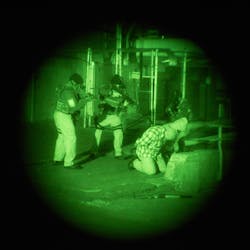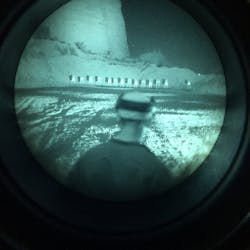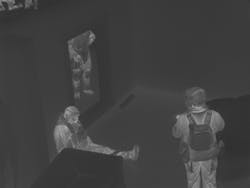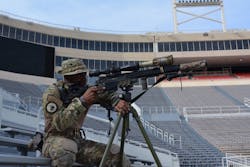Night Vision or Thermal: What’s Better for Your SWAT Operation?
Everyone knows that if you’re on the SWAT team, you have to have the coolest toys, the best weapons and the latest gadgets. Some of those gadgets help operators function in unfriendly conditions, and perhaps the greatest unfriendly condition officers face is low light or no light. There are several options for overcoming our lack of sight in low light conditions, including night vision and thermal sighting equipment. But is one “better” than the other for SWAT? Actually, they both serve good purposes, but it’s best to select the right tool for the job, and the “right tool” depends on the job at hand.
The technical differences
Night vision and thermal are two very distinct technologies. In a technical sense, night vision devices gather ambient light from starlight and moonlight from nearby area, or assisted by infra-red illuminators, explains Dale Suzuki, VP of Sales for FLIR Outdoor and Tactical Systems. Using the photons from the ambient light source, the night vision device will then capture this light source, which then goes through the imaging intensifier tube changing the photons to electrons.The electrons are then amplified and projected on to a phosphorus screen that changes the amplified electrons back into visible light, increasing light sensitivity. The image will now be detectable by the human eye in green or white contrast, based on the color of phosphor of the imaging intensifier tube, which effectively provides several thousand times better light sensitivity than the human eye. This allows the operator to see in the dark, explains Suzuki.
When it comes to thermal imagers, they are altogether different from night vision devices in application and in build, making pictures from heat, not visible light. “Everything we encounter in our day-to-day lives gives off thermal energy, even ice,” says Suzuki. “The hotter something is, the more thermal energy it emits. This emitted thermal energy is called a heat signature. When two objects next to one another have even subtly different heat signatures, they show up quite clearly to a FLIR regardless of lighting conditions. Because different materials absorb and radiate thermal energy at different rates, an area that we think of as being one temperature is a mosaic of subtly different temperatures. Therefore a log that’s been in the water for days on end will appear to be a different temperature than the water and is therefore visible to a thermal imager.” Heat (also called infrared or thermal energy) and light are both parts of the electromagnetic spectrum, but a camera that can detect visible light won’t see thermal energy, and vice versa. “Night vision devices have the same drawbacks that daylight and lowlight TV cameras do—they need enough light, and enough contrast to create usable images,” says Suzuki. Thermal imagers, on the other hand, see clearly day and night, while creating their own contrast in black or white and in multi-color.
While the technology differences may seem complex, their individual strengths lend themselves useful in specific applications, and application will be the driving force of which technology is “better.”
Applications matter most
Arguments often arise between SWAT operators: Which technology—night vision or thermal—is better for the SWAT team? There is no true right answer outside of the application.
Teams must first ask themselves: What environment are we using it for? What would be our current applications for the technology? What do the majority of our calls look like?
In a SWAT operation, target identification is a non-negotiable mandate for low light technology use. “If I’m going to use deadly force, I need to be able to identify my target,” says Mark Lang, a 19-year SWAT member of the Dallas Police Department (Texas). “Night vision allows you to do just that.Thermal does not.”
Night vision is also very flexible in that it can work in a lot of different environments—indoors and outdoors, cityscape, woodland scape, etc., says Jake Saul, international business development manager with Night Vision Devices (NVD). “You get to see a clear image of the surroundings in green hew or black and white hew. But it also allows you to have the ability for facial recognition. You can see clearly what people are wearing or holding or what they are doing.” Another benefit is that night vision can see through glass, where thermal cannot. “You can’t be in a vehicle and looking out, and you can’t be outside, looking into a vehicle [with thermal],” says Saul.
With night vision, however, operators have to worry about “washing out,” where light can bounce off of shiny objects and blind users for a second, says Suzuki, who also notes that night vision goggles (NVGs) and other lowlight cameras are not very useful during twilight hours. “There is too much light for them to work effectively, but not enough light for you to see with the naked eye,” he says. “Thermal cameras aren’t affected by visible light, so they can give you clear pictures even when you are looking into the setting sun.” Thermal is also ideal in rural SWAT operations if SWAT team members need to locate a suspect.
Although thermal imagers let a user say, “I know there is someone there,” knowing someone is there is not good enough when it comes to using deadly force, says Lang. “The two technologies are really not the same application, but used together, however, they can help you come to the best decision before you have to do something.”
In an ideal world you’d have both technologies in your kit bag. “Let’s say a SWAT officer gets called out to a barricaded suspect with a possible hostage situation,” says Suzuki. “Once they arrive at scene most likely in a stealth mode, they will have their night vision on to recognize friend from foe, identify targets, transition uniform patrol officers out of key tactical locations, replacing them with SWAT officers and controlling the perimeter. That scene can change dramatically if several suspects run into the middle of the woods behind the house. The SWAT officers will transition out of the stealth mode and into seek-search mission tempo. This is when the thermal imager will be deployed and will give the operator a distinct advantage to locate hot targets.”
While thermal is a great technology to have, not everyone on the team needs one, says Mark Cockman, western U.S. law enforcement sales manager with EOTECH. He notes that while every SWAT member will benefit with night vision, only several people on the team need thermal. If a SWAT team only has money to purchase one or the other, it really comes down to what the bulk of your calls are.
The Achilles heel
From a price comparison, the night vision and thermal can be similar, says NVD’s Saul. “Night vision handhelds and thermal handhelds can be about the same price,” he says. “A thermal helmet mounted monocular may cost as much as a night vision binocular. There are so many variables when it comes to initial cost because there are such a wide range of products.” Saul believes cost of ownership would be less with night vision, noting that warranties are generally longer and the technology, for the most part, lasts longer. “For a lot of guys who already know what they want, it comes down to form, function and price,” he says.
One of the biggest challenges when it comes to acquiring night vision is the price. “Night vision is one of the biggest expenses for the SWAT team,” says Lang. “There are just so many other expenses and needs on the SWAT team that really the price per unit of night vision is the Achilles heel. There are very few teams that can run a black out operation, where everybody has some type of night vision.” A team that can run a full black out is not the norm, but rather the exception. “There are still so many police snipers who do not have it,” says Lang.
How do you outfit your whole team? EOTECH’s Cockman says sometimes it takes teams several years, with some teams purchasing one or two binocular systems per quarter until their team is outfitted.
Agencies can pursue grant money to purchase night vision, too, but Lang notes it’s going to take a lot of leg work and may take months or years to get the funds. “Unfortunately it usually takes a bad deal or an operation for people to say, ‘Night vision would have been really critical in that operation.’” He still encourages agencies to take a closer look at integrating the technology into their SWAT team.They are no use without training
Whether you acquire night vision or thermal, you’re at a disadvantage if you don’t also budget for proper training. There are knowledge objectives to be learned that include operation, maintenance, protocols of use, storage and safety. For each knowledge objective, there’s an attached skill objective and the only way to truly master using night vision equipment or thermal is to use it, repeatedly. “I think SWAT teams do too much to try and figure it out themselves,” says Lang. “They do too much inbred training where all they know is all what the team knows.”
EOTECH’s Cockman strongly encourages users to travel to an intensive training, recommending the tactical training facility Direct Action Resource Center (DARC) where participants are put through a six day counter terrorism course. “Teams come back from that saying, ‘We are so far behind, we need to send the rest of the team,’” Cockman notes.
When it comes to choosing between adding thermal or night vision to your kit, dollars will be a limiting factor. The obvious answer is that a properly equipped team—budgets allowing—should have both types of equipment available. To that end, each has to be supported by training and protocol with potential applications practiced and mastered to the greatest extent.
Whole system approach

Adrienne Zimmer | Editor
Adrienne Zimmer was the Editor of Law Enforcement Technology magazine, a monthly business-to-business publication that covers technology trends and best practices for public safety managers from 2017 to 2019. LET is part of Officer Media Group, which also publishes Law Enforcement Product News and Officer.com. Adrienne has been in publishing since 2013.







